Coplanar Capillary Plasma Electrode Discharge Flat-Panel Lamps Based on Porous Anodic Alumina
Abstract
:1. Introduction
2. Fabrication Process and Testing of Coplanar CPED Flat-Panel Lamps
2.1. Fabrication of CBD Devices
- (1)
- A 70 μm pure aluminum foil (80 mm × 120 mm) was tightly bonded to a 3 mm thick ordinary glass under high temperature, high pressure, and an electric field. The mismatch between the expansion coefficients of the aluminum foil and ITO glass during the heat treatment process was solved in this manner.
- (2)
- Tar was coated on the aluminum foil using screen printing to obtain a mask film of the desired grid electrode structure. The tar-mask film was baked and solidified at 120 °C. The parameters in the tar coating process determined the interval distances and width of the CBD device. In this study, the interval distances of the CBD device were 0.5 and 1.0 mm. The width was taken as 1 mm.
- (3)
- The samples above were then electrochemically reacted in a 0.3 M oxalic acid solution at 15 °C until the reaction current was reduced from 300 mA to 0 mA, which indicated that all the aluminum not blocked by the tar-mask films was electrolyzed into Al2O3.
- (4)
- The tar-mask films were removed, and the samples were placed in an oxalic acid solution to continue the electrochemical reaction. After approximately 40 min, the thickness of the alumina layer reached the desired thickness, which was approximately 25 μm. The electrochemical reaction was complete, and a coplanar CPED device for CPED flat-panel lamps was obtained.
2.2. Fabrication of Coplanar CPED Flat-Panel Lamps
- (1)
- White fluorescent powder was mixed with glue and coated onto the surface of the CBD devices via screen printing. When the mass concentration of the fluorescent powder was approximately 60%, the thickness of the fluorescent powder on the coplanar CPED device was approximately 65 μm.
- (2)
- A 3 mm transparent glass plate was used as the front plate, and the coplanar CPED device coated with fluorescent powder was used as the back plate. PbO was used as an adhesive to encapsulate the front and back plates in a box with a gap of 3 mm. Thus, the planar CPED flat-panel plasma lamp was fabricated.
2.3. Testing Process of CBD Flat-Panel Lamps
2.4. Results and Discussion
2.4.1. Influence of Interval Distance of Electrodes on the Spark-Ignition Voltage
2.4.2. Influence of Pressure on Luminous Efficacy of Coplanar CPED Flat-Panel Lamps
3. Simulation of Coplanar CPED with Porous Anodic Alumina
3.1. Electron Density Distribution
3.2. Results
4. Discussion
5. Conclusions
Author Contributions
Funding
Institutional Review Board Statement
Informed Consent Statement
Data Availability Statement
Conflicts of Interest
References
- Fridman, A.; Chirokov, A.; Gutsol, A. Non-thermal atmospheric pressure discharges. J. Phys. D Appl. Phys. 2005, 38, R1–R24. [Google Scholar] [CrossRef]
- Kogelschatz, U. Dielectric-barrier Discharges: Their History, Discharge Physics, and Industrial Applications. Plasma Chem. Plasma Process. 2003, 23, 1–46. [Google Scholar] [CrossRef]
- De Geyter, N.; Morent, R.; Leys, C.; Gengembre, L.; Payen, E. Treatment of polymer films with a dielectric barrier discharge in air, helium and argon at medium pressure. Surf. Coat. Technol. 2007, 201, 7066–7075. [Google Scholar] [CrossRef]
- Wagner, H.-E.; Brandenburg, R.; Kozlov, K.; Sonnenfeld, A.; Michel, P.; Behnke, J. The barrier discharge: Basic properties and applications to surface treatment. Vacuum 2003, 71, 417–436. [Google Scholar] [CrossRef] [Green Version]
- Liu, Y.H.; Li, J.; Liu, D.P.; Benstetter, G. Properties and deposition processes of a-C: H films from CH4/Ar dielectric barrier discharge plasmas. Surf. Coat. Technol. 2006, 200, 5819–5825. [Google Scholar] [CrossRef]
- Kun, W.; Jian, L.; Jing, X. Research on cylindrical surface wave plasma fluorescent lamps. J. Eng. Sci. Technol. Rev. 2013, 6, 164–167. [Google Scholar]
- Kun, W.; Jian, L.; Shiqing, W. Study on Illumination Properties of Fluorescent Lamps Driven by Surface Wave Plasma. Energy Educ. Sci. Technol. Part A Energy Sci. Res. 2013, 31, 2777–2780. [Google Scholar]
- Kun, W.; Shiqing, W.; Jian, L. Design of Flat-Panel Lamp Generated by Coplanar Dielectric Barrier Discharge Plasma. Chin. J. Vac. Sci. Technol. 2020, 40, 1119–1123. [Google Scholar]
- Kunhardt, E.E.; Becker, K.H. Glow Plasma Discharge Device Having Electrode Covered with Perforated Dielectric. U.S. Patent US005872426A, 16 February 1999. [Google Scholar]
- Kunhardt, E. Generation of Large-Volume, Atmospheric-Pressure, Nonequilibrium Plasmas. IEEE Trans. Plasma Sci. 2000, 28, 189–200. [Google Scholar] [CrossRef]
- Park, S.-H.; Cho, T.-S.; Becker, K.H.; Kunhardt, E.E. Capillary Plasma Electrode Discharge as an Intense and Efficient Source of Vacuum Ultraviolet Radiation for Plasma Display. IEEE Trans. Plasma Sci. 2009, 37, 1611–1614. [Google Scholar] [CrossRef]
- Panikov, N.; Paduraru, S.; Crowe, R.; Ricatto, P.; Christodoulatos, C.; Becker, K. Destruction of Bacillus Subtilis Cells Using an Atmospheric-Pressure Capillary Plasma Electrode Discharge. IEEE Trans. Plasma Sci. 2002, 30, 1424–1428. [Google Scholar] [CrossRef]
- Moskwinski, L. Study of Atmospheric Pressure Capillary Plasma Electrode Discharge; Faculty of the Stevens Institute of Technology: Hoboken, NJ, USA, 2009. [Google Scholar]
- Becker, K.H.; Schoenbach, K.H.; Eden, J.G. Microplasmas and applications. J. Phys. D Appl. Phys. 2006, 39, R55–R70. [Google Scholar] [CrossRef]
- Koutsospyros, A.; Yin, S.-M.; Christodoulatos, C.; Becker, K. Destruction of hydrocarbons in non-thermal, ambient-pressure, capillary discharge plasmas. Int. J. Mass Spectrom. 2004, 233, 305–315. [Google Scholar] [CrossRef]
- Poudel, M.B.; Lohani, P.C.; Kim, A.A. Synthesis of silvernanoparticles decorated tungsten oxide nanorod as high-performance supercapacitor electrode. Chem. Phys. Lett. 2022, 804, 139884. [Google Scholar] [CrossRef]
- Poudel, M.B.; Prasad Awasthi, G.; Kim, H.J. Novel insight into the adsorption of Cr(VI) and Pb(II) ions by MOF derived Co-Al layered double hydroxide @hematite nanorods on 3D porous carbon nanofibernetwork. Chem. Eng. J. 2021, 417, 129312. [Google Scholar] [CrossRef]
- Poudel, M.B.; Kim, A.R.; Ramakrishan, S.; Yoo, D.J. Integrating the essence of metal organic frame work-derived ZnCoTe-N-C/MoS2 cathode and ZnCo-Nps-N-CNT as anode for high-energy density hybrid supercapacitors. Compos. Part B 2022, 247, 110339. [Google Scholar] [CrossRef]
- Ghaforyan, H.; Ebrahimzadeh, M. Self-Organized Formation of Hexagonal Pore Arrays in Anodic Alumina Fabrication. J. Mater. Sci. Eng. 2011, 1, 82–85. [Google Scholar]
- Ono, S.; Saito, M.; Asoh, H. Self-Ordering of Anodic Porous Alumina Induced by Local Current Concentration: Burning. Electrochem. Solid-State Lett. 2004, 7, B21–B24. [Google Scholar] [CrossRef]
- Kawasaki, T. Manufacturing of anodic porous alumina for barriers in a dielectric barrier discharge reactor. J. Electrost. 2008, 66, 395–400. [Google Scholar] [CrossRef]
- Jessensky, O.; Müller, F.; Gösele, U. Self-organized formation of hexagonal pore arrays in anodic alumina. Appl. Phys. Lett. 1998, 72, 1173–1175. [Google Scholar] [CrossRef] [Green Version]
- Li, F.; Zhang, L.; Metzger, R.M. On the Growth of Highly Ordered Pores in Anodized Aluminum Oxide. Chem. Mater. 1998, 10, 2470–2480. [Google Scholar] [CrossRef]
- Asoh, H.; Nishio, K.; Nakao, M.; Tamamura, T.; Masuda, H. Conditions for Fabrication of Ideally ordered Anodic Porous Alumina Using Pretextured Al. J. Electrochem. Soc. 2001, 148, B152–B156. [Google Scholar] [CrossRef]
- Park, S.-J.; Eden, J.G. Microdischarge Devices with a Nanoporous Al2O3 Dielectric: Operation in Ne and Air. IEEE Trans. Plasma Sci. 2005, 33, 572–573. [Google Scholar] [CrossRef]
- Hussain, S.; Qazi, H.I.A.; Badar, M.A. Characteristics of radio-frequency atmospheric pressure dielectric-barrier discharge with dielectric electrodes. Phys. Plasma 2014, 21, 030702. [Google Scholar] [CrossRef]
- Hussain, S.; Qazi, H.I.A.; Malik, A.A.; Badar, M.A. Glow Modes in Radio Frequency Atmospheric Discharge Operating with and Without Anodized Electrodes. IEEE Trans. Plasma Sci. 2014, 42, 2410–2411. [Google Scholar] [CrossRef]
- Qazi, H.I.A.; Sharif, M.; Hussain, S.; Badar, M.A.; Afzal, H. Spectroscopic Study of a Radio-Frequency Atmospheric Pressure Dielectric Barrier Discharge with Anodic Alumina as the Dielectric. Plasma Sci. Technol. 2013, 15, 900–903. [Google Scholar] [CrossRef]
- Abidat, R.; Rebiai, S.; Benterrouche, L. Numerical Simulation of Atmospheric Dielectric Barrier Discharge in Helium gas using COMSOL Multiphysics. In Proceedings of the 3rd International Conference on Systems and Control, Algiers, Algeria, 17–19 August 2013; pp. 29–31. [Google Scholar]
- Jovanovic, A.P.; Stankov, M.N.; Loffhagen, D.; Becker, M.M. Automated Fluid Model Generation and Numerical Analysis of Dielectric Barrier Discharges Using Comsol. IEEE Trans. Plasma Sci. 2021, 49, 3710–3718. [Google Scholar] [CrossRef]
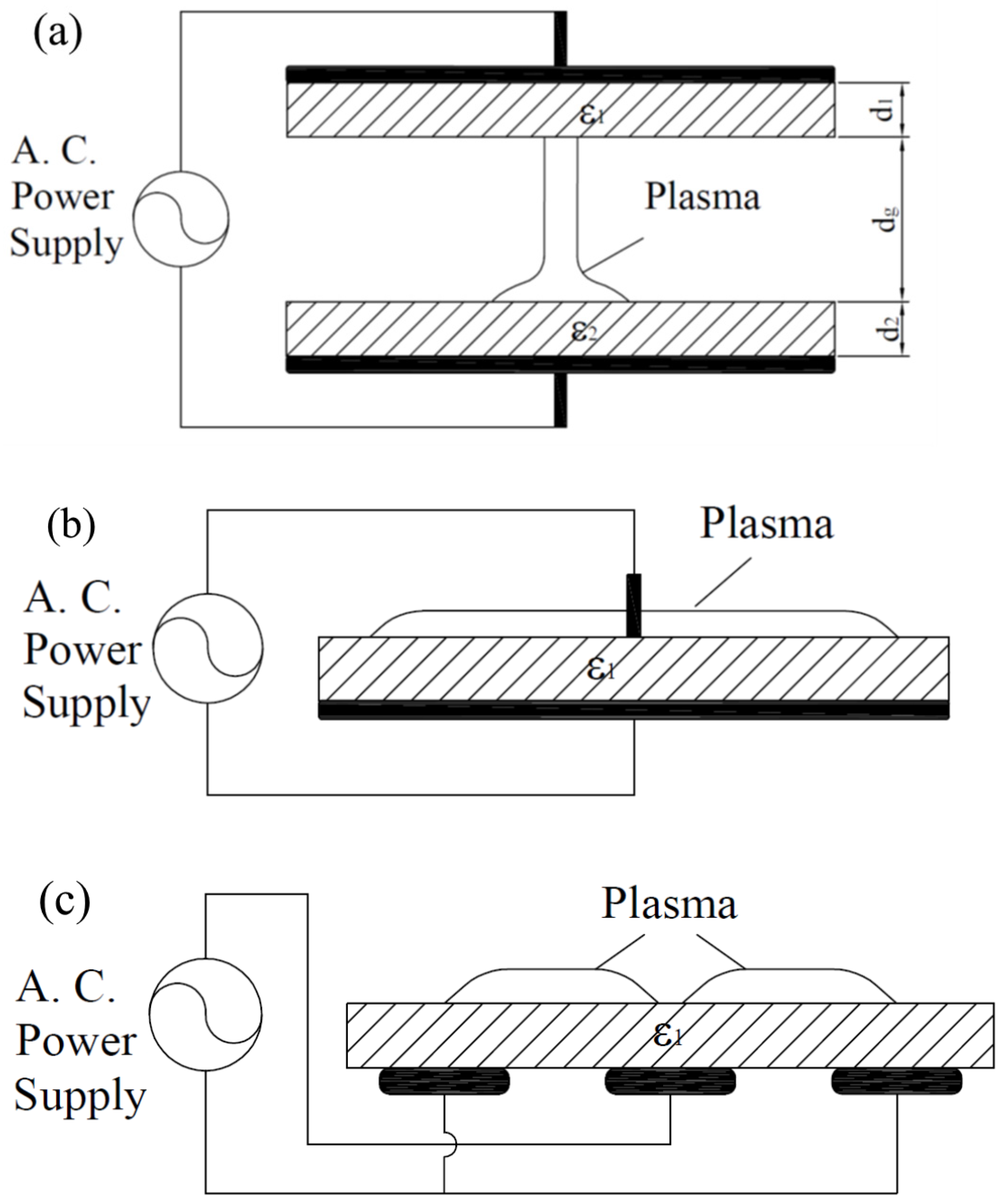


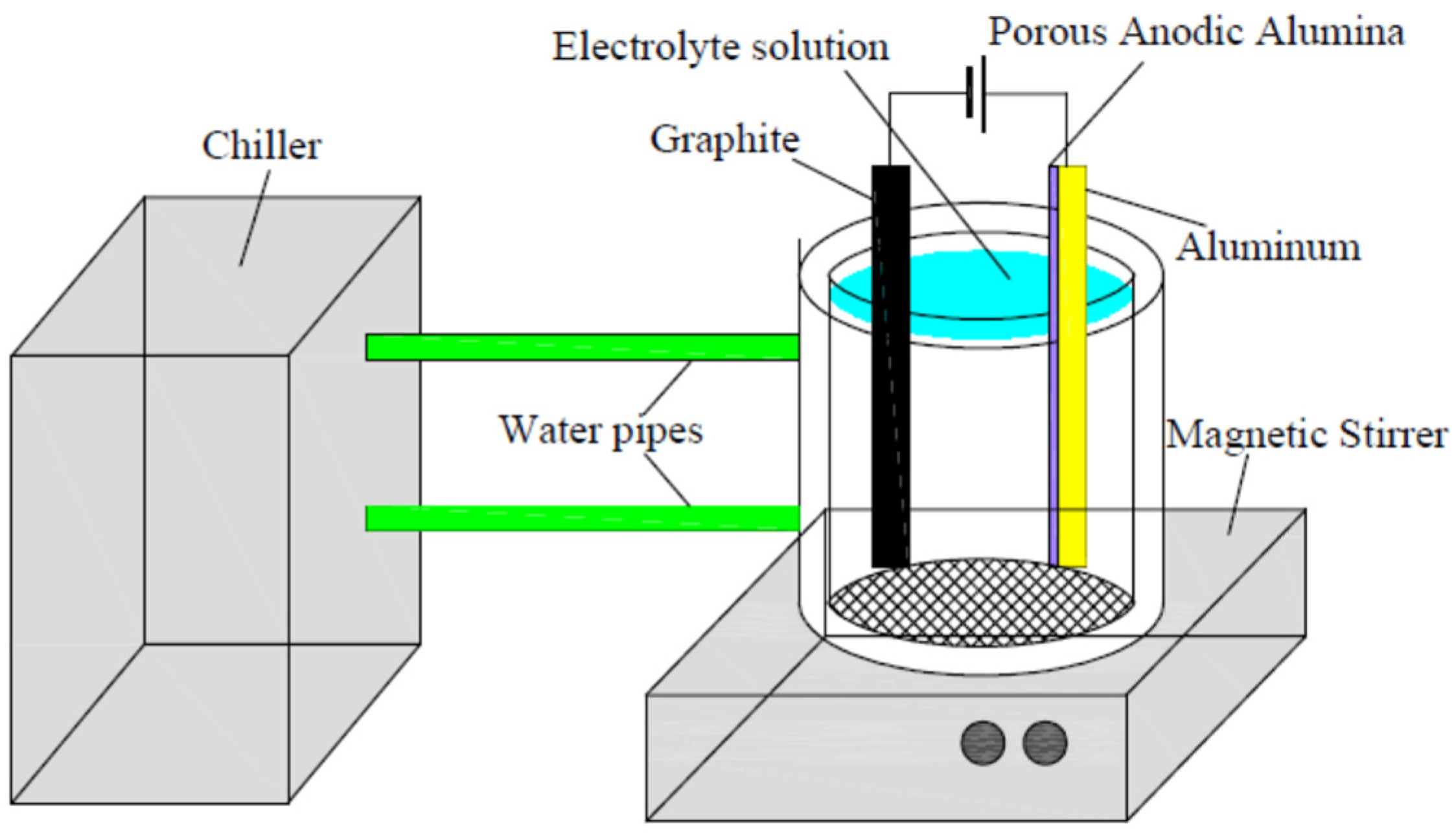
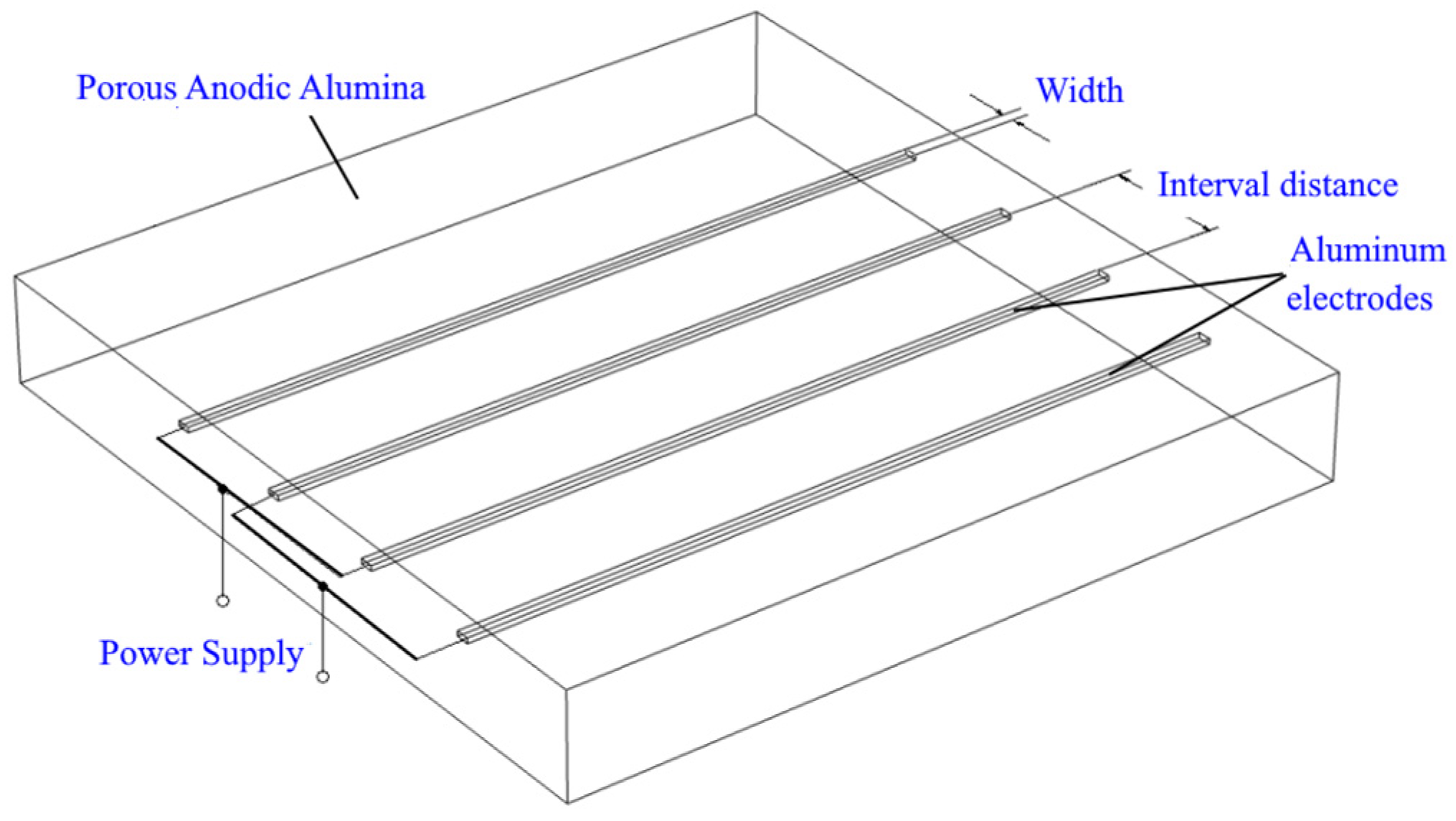
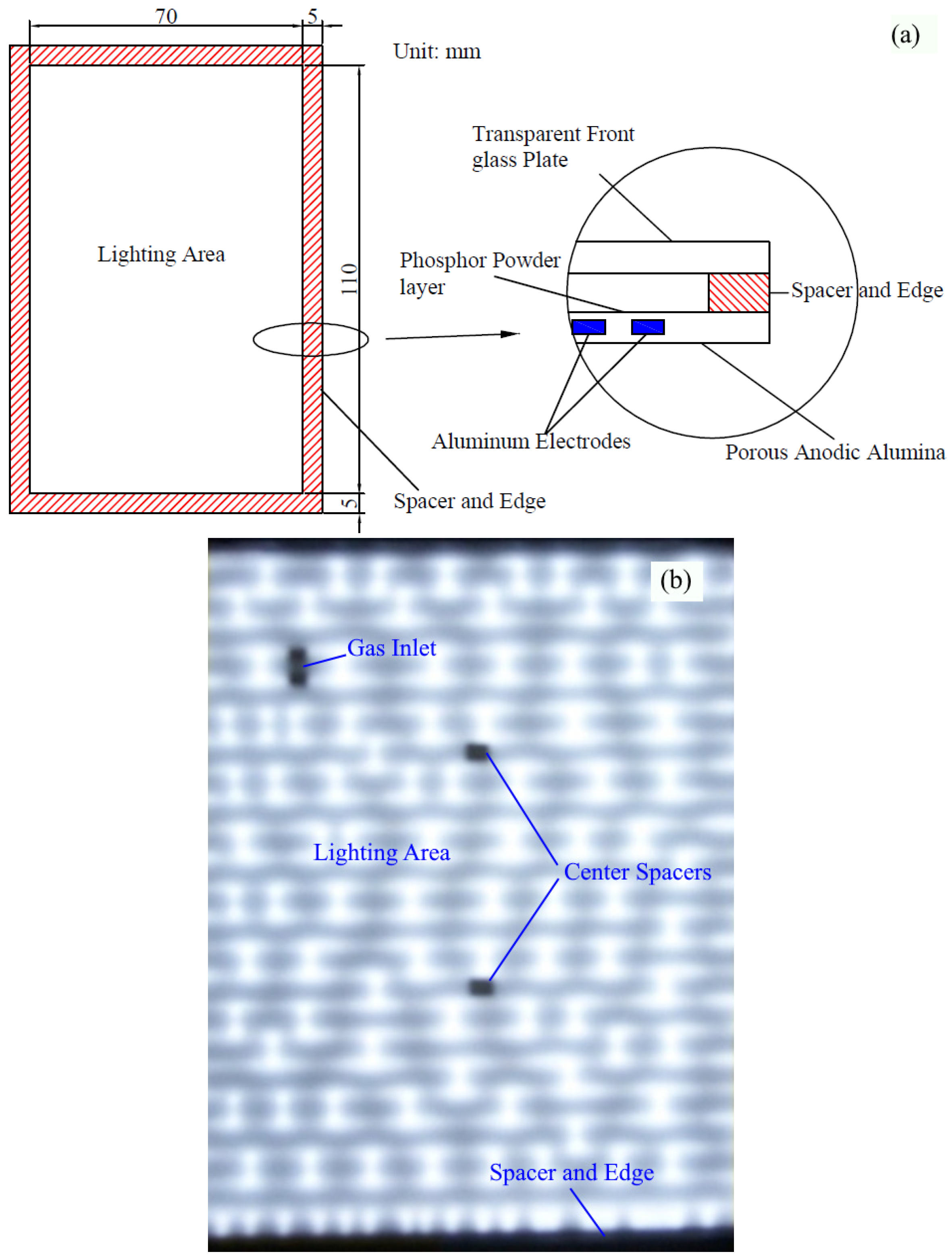
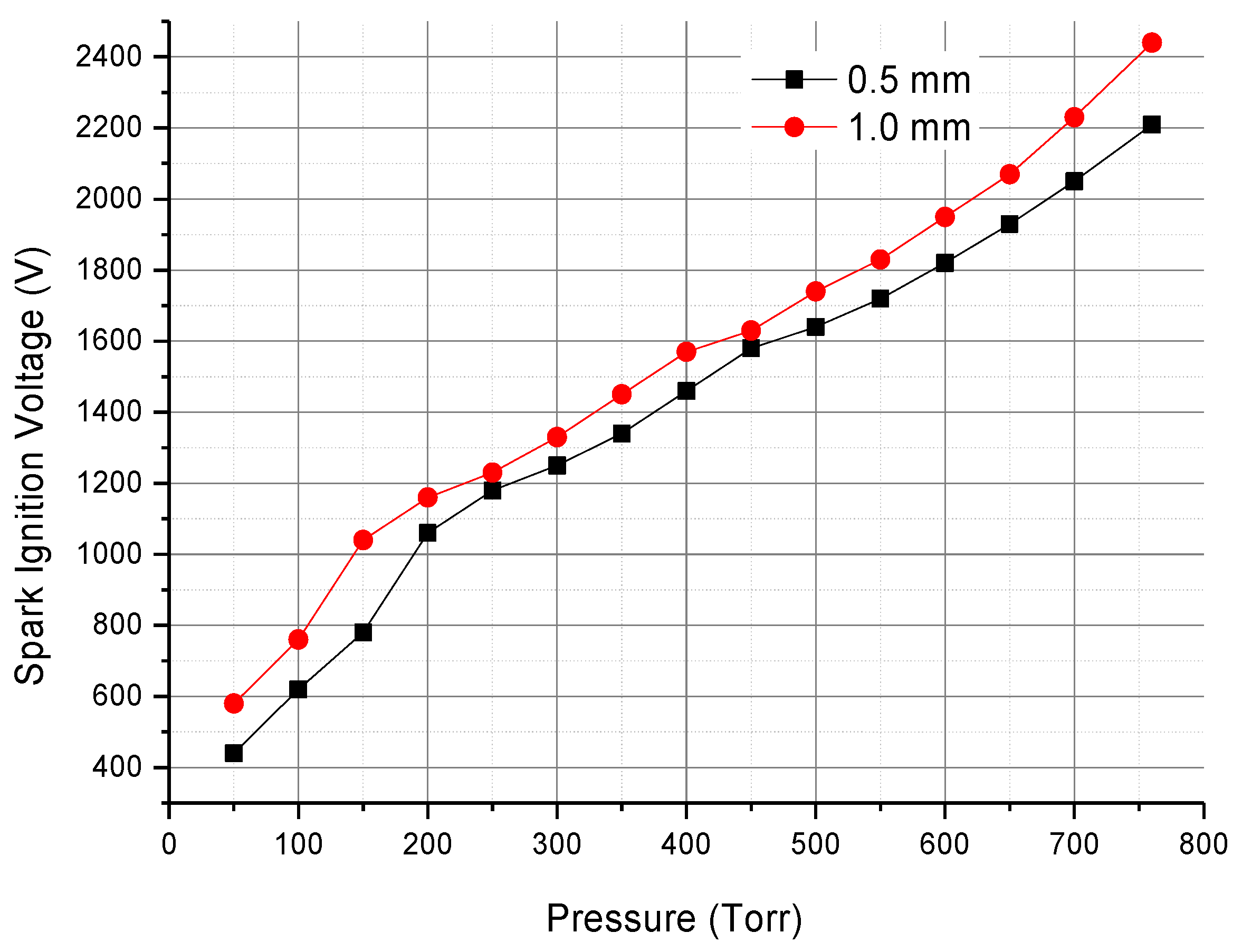

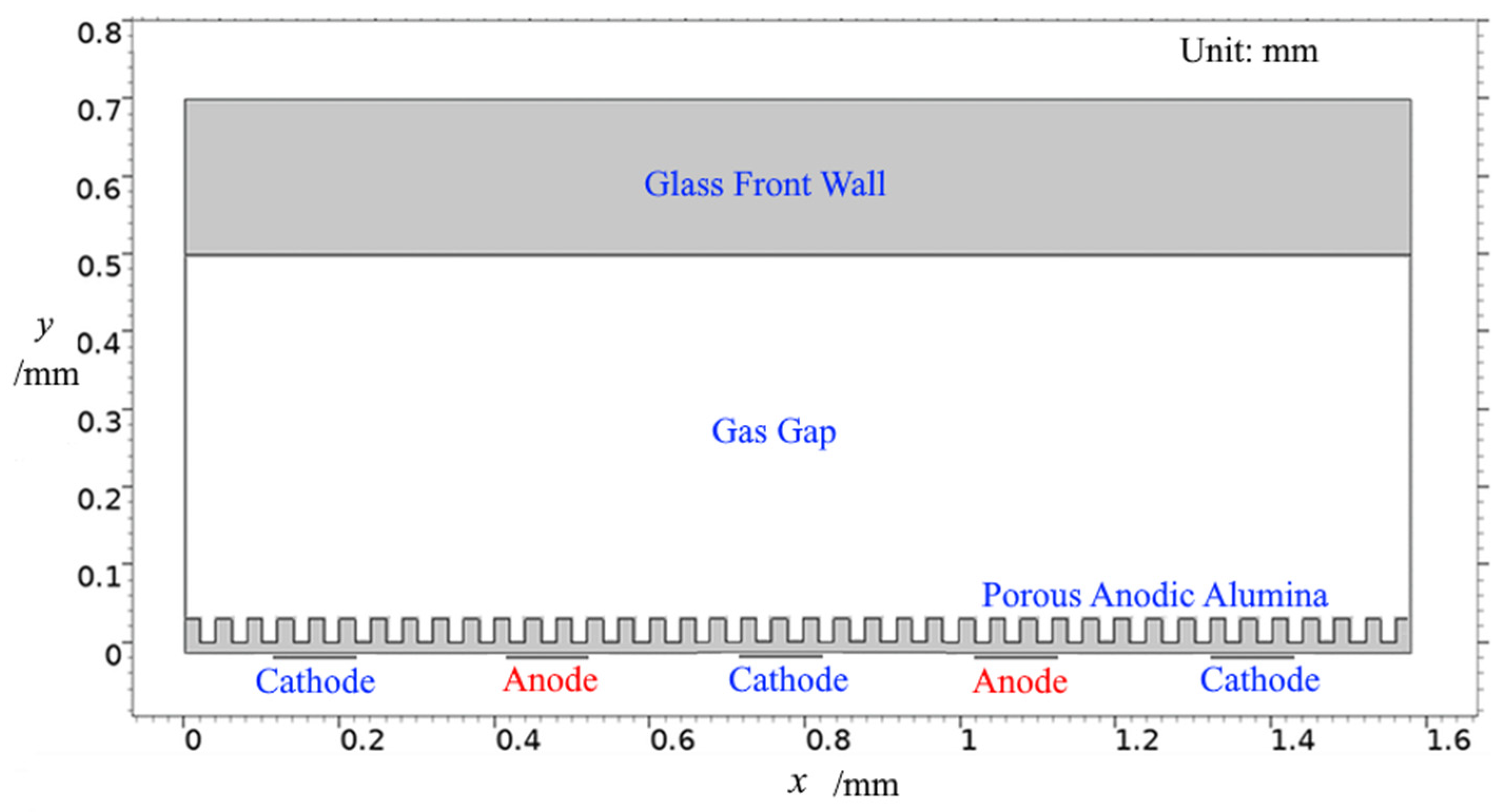
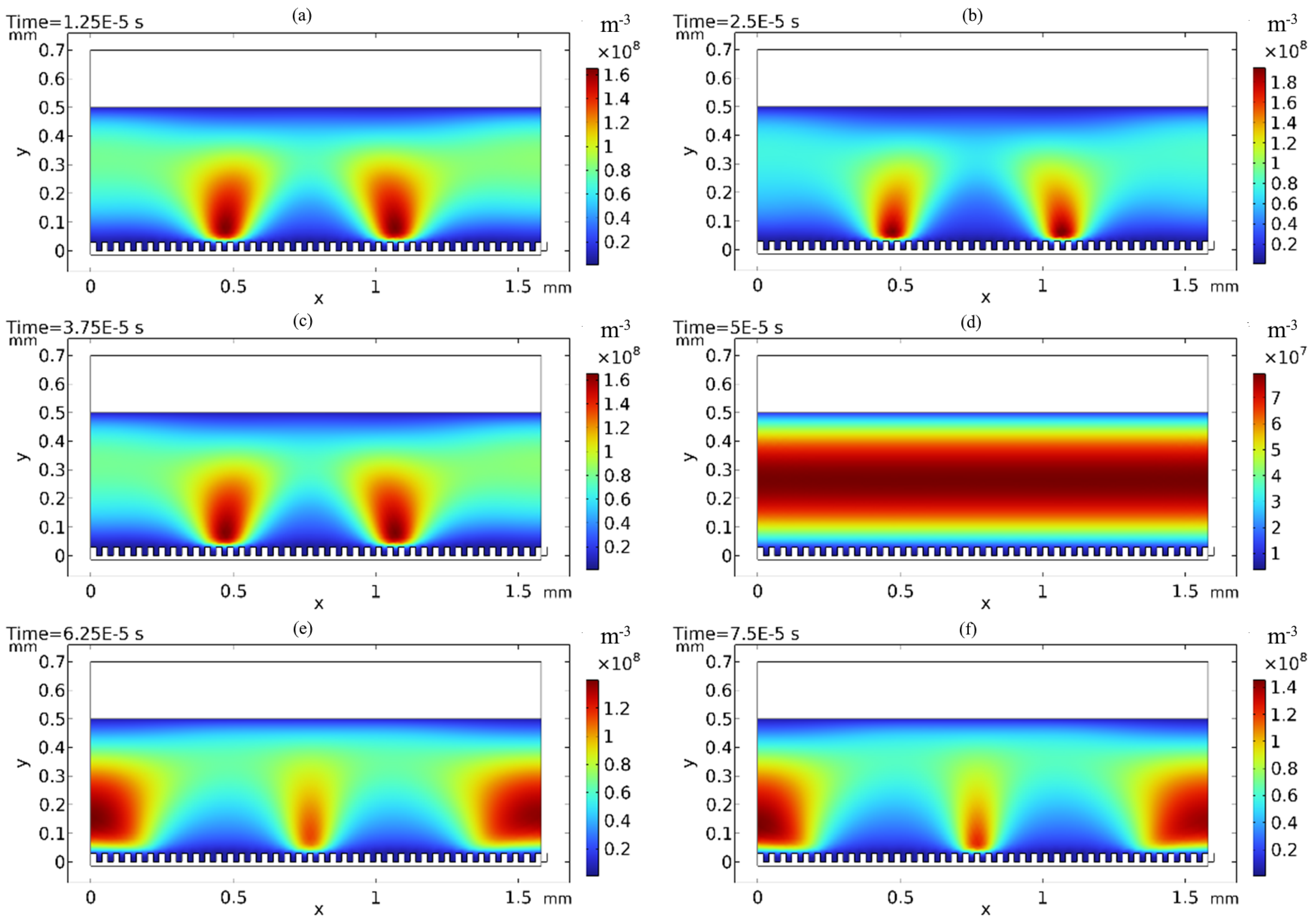


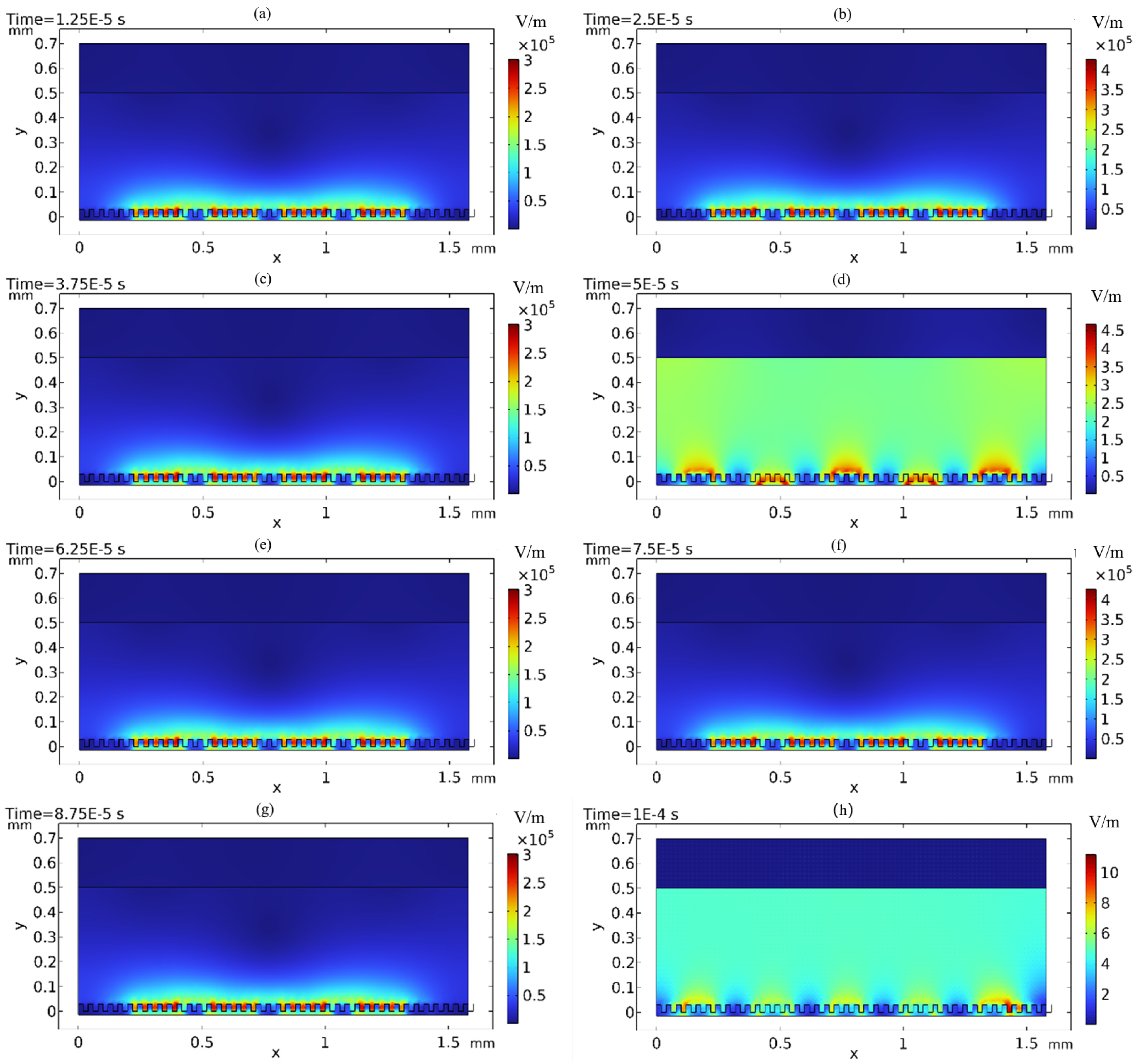
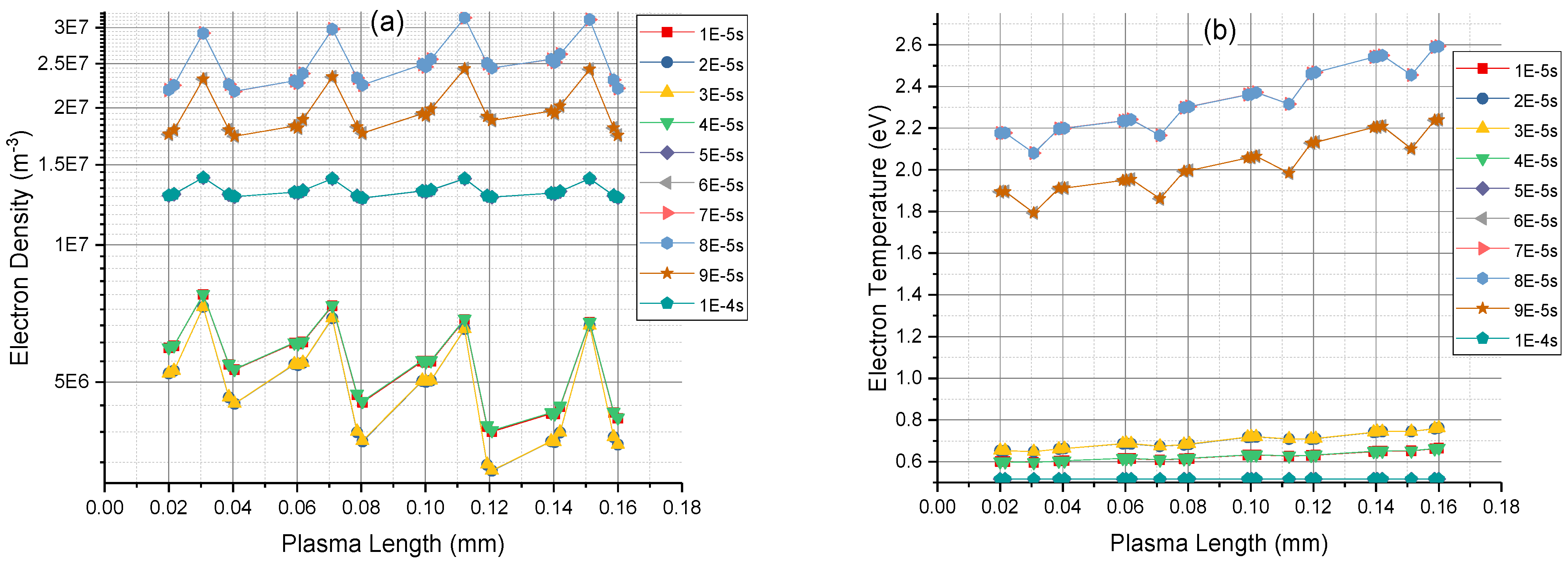
| Variables | dg/mm | dw1/mm | d/mm | d1/mm | Dp/mm | r |
|---|---|---|---|---|---|---|
| Description | Distance of gas gap | Width of electrode | Distance between electrodes | Thickness of PAA bottom | Diameter of pore | Ratio of depth to diameter |
| Values | 0.50 | 0.01 | 0.02 | 0.014 | 0.02 | 1.5 |
| No. | Reactions |
|---|---|
| 1 | e + Ar => e + Ar |
| 2 | e + Ar => e + Ar* |
| 3 | e + Ar => e + Ar |
| 4 | e + Ar* => 2e + Ar+ |
| 5 | e + Ar* => 2e + Ar+ |
| 6 | Ar* + Ar* => e + Ar + Ar+ |
| 7 | Ar* + Ar => Ar + Ar |
Disclaimer/Publisher’s Note: The statements, opinions and data contained in all publications are solely those of the individual author(s) and contributor(s) and not of MDPI and/or the editor(s). MDPI and/or the editor(s) disclaim responsibility for any injury to people or property resulting from any ideas, methods, instructions or products referred to in the content. |
© 2023 by the authors. Licensee MDPI, Basel, Switzerland. This article is an open access article distributed under the terms and conditions of the Creative Commons Attribution (CC BY) license (https://creativecommons.org/licenses/by/4.0/).
Share and Cite
Wang, K.; Wang, S.-Q.; Li, J.; Dan, M.; Jin, F.-Y. Coplanar Capillary Plasma Electrode Discharge Flat-Panel Lamps Based on Porous Anodic Alumina. Appl. Sci. 2023, 13, 3881. https://doi.org/10.3390/app13063881
Wang K, Wang S-Q, Li J, Dan M, Jin F-Y. Coplanar Capillary Plasma Electrode Discharge Flat-Panel Lamps Based on Porous Anodic Alumina. Applied Sciences. 2023; 13(6):3881. https://doi.org/10.3390/app13063881
Chicago/Turabian StyleWang, Kun, Shi-Qing Wang, Jian Li, Min Dan, and Fan-Ya Jin. 2023. "Coplanar Capillary Plasma Electrode Discharge Flat-Panel Lamps Based on Porous Anodic Alumina" Applied Sciences 13, no. 6: 3881. https://doi.org/10.3390/app13063881





